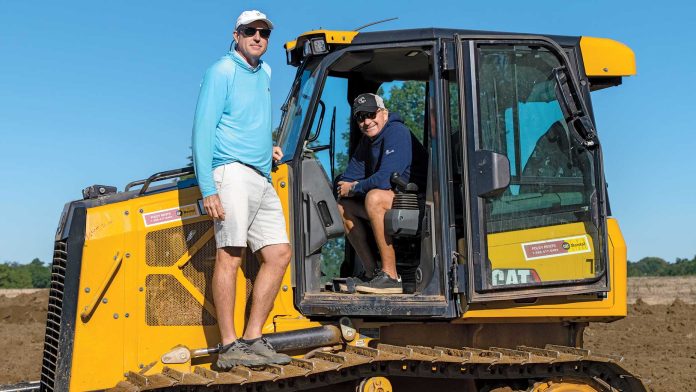To say that Golden Gate Park in San Francisco, epicenter of the Summer of Love, has looser codes of conduct than those enforced at the city’s private golf clubs is an understatement on the scale of calling Tiger Woods a stick. The worlds are as different as tweed and tie-dye. But on a recent Northern California swing, Gil Hanse moved easily between them. The acclaimed architect had winged west for a weekend that blended business with patchouli-scented pleasure. High on his agenda was a celebration of the 60th anniversary of his favorite band, the Grateful Dead, whose offshoot, Dead & Company, were performing in the park. Hanse had tickets to all three shows.
His schedule, though, was jam-packed in more ways than one. When he wasn’t grooving to the strains of “Cassidy” and “Scarlet Begonias,” Hanse made the rounds at a handful of recent and pending commissions.
He checked in at the Olympic Club, which he and his longtime design partner, Jim Wagner, had updated in 2023, dropped by Lake Merced, where they had revived an Alister MacKenzie layout, and met with San Francisco Golf Club, one of the country’s most exclusive enclaves, to start hashing out a new master plan.
All of those commitments were clustered within a few miles of the park, letting Hanse hopscotch from the concert venue to the clubs and back. A longer drive awaited. Before his trip was over, Hanse would motor two hours south to Monterey for conversations around Spanish Bay, the Pebble Beach Resort course that will go under his knife next year.
His counterpart, meanwhile, had a full slate of his own. On the far side of the country, Wagner was knee-deep in the finer points of High Grove, a private club in a Florida orange grove that will have its ribbon cutting in January, about a month after member play commences at Childress Hall, a Hanse/Wagner original in Eastern Texas.
“Jim and I balance each other out nicely, but we don’t see each other very often,” Hanse says. “These days, we’re like ships passing in the night.”
“Weir everywhere,” Deadheads like to say, as in the band’s cofounder Bob Weir. Something similar could be said of Hanse and Wagner. In the nearly 30 years since they joined forces under Hanse Golf Course Design, the two have built a portfolio as far-flung and varied as any in modern golf design. They have stitched fairways through central France’s Loire Valley, dropped layouts in the sandhills of Nebraska, shaped seaside holes in the Scottish Highlands, etched playing corridors through the desert outskirts of Palm Springs, to name just a sampling.
In an era of explosive industry growth, no architects have been in greater demand or laid their hands on more headline projects. Of the courses on GOLF’s World Top 100 and U.S. Top 100 lists, Hanse and Wagner have left their imprint on nearly two dozen. These range from fresh builds such as CapRock Ranch and Castle Stuart to a list of restorations that reads like a roll call of sacred ground: Winged Foot, Oakmont, Merion, The Country Club, Los Angles Country Club, and on.
While much of their work has been for private clubs and wealthy owners, the pair have also poured their hearts, pro bono, into municipal courses with socially conscious missions and other standout public-access tracks — projects that provide what Hanse calls “particularly good vibes.”
In some circles, the pace and volume of their output has prompted snarky comments — “Is there a job they aren’t doing?” — and a skeptical question: How can the quality keep up with the quantity?
The rejoinders are simple: The courses keep meeting with critical acclaim, and the clients keep lining up.
“When it comes down to it, there’s a proven track record,” says Ran Morrissett, GOLF’s former architecture editor and cofounder of the design-focused website Golf Club Atlas. “If you’re a club or an owner trying to build something special, you know they’re going to get it right.”
The architects, for their part, point to safeguards that keep them from getting spread too thin. For starters, Hanse says, “We politely turn down 90 percent of what we’re offered.” They also divvy up the labor. Central to that strategy is an inner circle of shapers, known affectionately as the “cavemen,” who travel from site to site, translating sketches and concepts into ground forms. Hanse and Wagner also lean on a yin-yang dynamic.
“We’re really at our best when Gil is selling and Jim is yelling,” Wagner says.
Hanse, a Jim Nantz–smooth extemporaneous speaker with a gift for delicate diplomacy, is better in the boardroom, while Wagner is more at ease barking at contractors. The contrast frees them up to tag-team projects and helps explain why they’re rarely in the same place at once.
“If we’re together,” Wagner says, “it probably means that something’s not getting done.”
;)
CHANNING BENJAMIN
Whatever the project, in staggered shifts, both make a point of spending ample time on-site. Their hands-on approach left a lasting impression on Irving Azoff, the music-industry magnate and longtime manager of The Eagles who, with Apple exec Eddy Cue, hired Hanse and Wagner to design and build Ladera, an artfully rugged layout in the Coachella Valley.
“I liken them to the great record producers of the ’70s,” Azoff says. “I’m talking vinyl, analog. No short cuts. They’re trust artists, and they’re committed to putting in the work.”
Another musical comparison comes from Dead & Company keyboardist Jeff Chimenti, a close friend of Hanse and a Lake Merced member.
“They’re a bit like a band where everyone has a role,” says Chimenti. “They also work around a central idea, but with a lot of improvisation.”
The soundtrack syncs.
“Most of the time,” Hanse says, “I just want to get on the bulldozer, listen to the Grateful Dead and build.”
That affinity goes back to 1979, when he was 16, and, in Deadhead parlance, first “got on the bus.” Growing up in New York, he enjoyed golf, but it was the landscape that really grabbed him — he was as likely to doodle golf holes as he was to play them. The same visual streak drew him to the Dead: the skull-and-lightning iconography as much as the music. He wore their Steal Your Face logo on a jean jacket, ringed in roses, and rode a train to Madison Square Garden for his first show. Two friends passed out not long after it started. Hanse stayed wide-eyed. He was hooked.
Instead of chasing shows, he pursued education. At the University of Denver he studied history and political science, then went on to Cornell for graduate work in city planning. There, he discovered a direct path into the game, one blazed a few years earlier by fellow Cornellian Tom Doak: a degree in landscape architecture and a life in golf design.
Supported by a scholarship — the same stipend that Doak had won before him — Hanse spent an immersive year in Scotland. Back in the States, the Cornell connection deepened. In 1989, fresh out of grad school, Hanse signed on as Doak’s lead design associate.
It was a formative stretch. Hanse soaked up lessons on routing and restraint while sharpening his skills on big machines. The two men had complementary temperaments — Doak the outspoken iconoclast, Hanse the diplomatic counterweight — and Hanse believed their differences could seed a successful partnership. But the two couldn’t agree to terms. Nearly four years into his tenure with Doak, Hanse was at a crossroads. He and his wife, Tracey, had just welcomed their second child. He had bills and ambitions. Something had to give.
“It was fight or flight,” Hanse says. “I thought, I’ve got two kids, a wife and a belief in myself. Do I settle into a situation that’s not going to become a partnership? Or do I do the right thing for my family and my career? So I took a leap of faith.”
That risk was rewarded with modest commissions around the Northeast, including work at Delaware Country Club, where a young up-and-comer named Jim Wagner had been appointed superintendent.
Born and raised in Philadelphia, with the accent to prove it (“golf” in his rendering is gawf), Wagner had a background in agronomy and construction along with an interest in design. As a kid, he’d been a “fence member” at several classic clubs in suburban Philly. Some of his buddies caddied at Merion, so he got to play there too.
“I didn’t know it at the time, but when you’re around all that great architecture, you can’t help but learn something,” Wagner says. “It basically happens by osmosis.”
Personally and professionally, he and Hanse clicked. In 1996, they formalized a partnership. Neither could have forecast where it would go.
“It’s one of those things where you wake up one day and realize that you’re not this little boutique company anymore,” Wagner says.
;)
Brian Oar
Businesses often grow the way one of Hemingway’s characters went broke: gradually, then suddenly. For Hanse and Wagner, every commission mattered, but a few figured more prominently in their rise.
An early break came from overseas. While studying in Scotland, Hanse struck up a friendship with Graeme Lennie, the head pro at Crail, one of the world’s oldest golf clubs. The bond began with a cheeky encounter — Hanse, dressed in black jeans and red high-top Converse (“It was the ’80s,” Hanse says. “What else were you going to wear?”), popped into Crail’s pro shop unannounced and asked if he could stroll the historic grounds. Instead of showing him the door, Lennie invited Hanse to show himself around — and invited him back on another day “properly attired” to browse his own collection of golf architecture books. The two stayed in close touch. Years later, when Crail decided to build a second course, Lennie helped Hanse get his hat in the ring.
His competition included such high-profile architects as Robert Trent Jones Sr., who mailed a book but skipped the interview. Hanse showed up in person, made his case and got the job, emerging from relative obscurity to become just the third American, after Jack Nicklaus and Tom Weiskopf, to design a course in Scotland.
Craighead Links opened in 1998 — Hanse and Wagner’s first original design and a cool calling card. Other assignments followed, none more pivotal than Boston Golf Club.
Built on rugged, wooded ground south of the city, Boston Golf Club gave the pair everything they could have hoped for: a generous budget, ample time and a client willing to let them push boundaries. It was a statement piece. It also drew influential members, including PGA Tour pro Brad Faxon and Seth Waugh, then CEO of Deutsche Bank and future head of the PGA of America. Waugh helped pave the way for a Hanse/Wagner renovation of TPC Boston, a Tour stop, which got their work on TV and caught the eye of Kingsbarns developer Mark Parsinen, who tapped the duo for his next project, Castle Stuart, in the Scottish Highlands, which opened in 2009.
By then, Hanse and Wagner had built a résumé of prestigious restorations — Fishers Island, Kittansett and the Creek among them — and a glowing reputation in the trade. Even so, they were underdogs when the International Olympic Committee went searching for someone to build a new course from scratch for the 2016 games in Rio. Hanse’s gift for presentations — and his willingness to relocate — helped him win the bid over heavyweights like Nicklaus and Doak. The Olympics were next-level global recognition.
“At that point, we were really off to the races,” Hanse says.
Years ago, Hanse and Wagner worked for an owner who insisted that they install cart paths before moving forward with the course.
“He had a Cadillac, and he wanted to be able to drive around and see what we were doing,” Hanse says.
They can now afford to say no to such jobs. Though Hanse won’t talk numbers (“It can sound like bragging, and besides, it’s not why we do this,” he says), it’s well known in the industry that design fees for top architects routinely reach into seven figures. That level of commitment requires serious clients. When they were starting out, Hanse and Wagner figured that for every 10 offers they agreed to, seven would probably go away.
“We now assume that every project is real, so we have to be careful and conscientious about what we choose,” Hanse says.
Their first condition is that golf, not real estate, be the focus on compelling land that allows for a walkable layout. Because the site dictates the style, not the other way around, some courses might be siblings but never twins. Both men take pride in the fact that it’s tough to tag their work with a “signature” trait.
;)
Courtesy Gil Hanse
If there’s a guiding aesthetic, it’s what Wagner describes as “genteel neglect.” Hanse draws an analogy that he credits to his and Wagner’s friend and mentor, Bill Kittleman, the former head pro at Merion, who, at 92, remains their design consultant.
“Bill would talk about courses as those old tapestries you might see hanging in 11th-century castles,” Hanse says. “In the center they are vibrant and tightly wound, but at the edges they become more frayed and tattered. A lot of great courses get blurry, where it’s hard to tell where the course ends and the native landscape begins.”
Anyone who has played Ohoopee Match Club, in Georgia, where firm playing corridors flow seamlessly into sand and scrub, has seen this design philosophy in effect.
Completed in 2018, Ohoopee is Hanse and Wagner’s second-highest-ranked original course, bested only by CapRock Ranch, which opened in 2021, in the chop hills of Nebraska.
Rural areas, of course, provide more opportunity for new work, while urban centers have been hotbeds for the duo’s restorations. There is, however, one conspicuous gap in their résumé. For all their reach, Hanse and Wagner have never built a course for the Keisers — not Mike, the patriarch behind Bandon Dunes, nor his sons, Michael and Chris, whose projects include Sand Valley, Rodeo Dunes and Wild Spring Dunes. The omission seems to sting Hanse, though he’s too diplomatic to say so.
From Michael Keiser’s standpoint, the timing just hasn’t lined up. “I love Gil’s work,” he says. “He and Jim are incredibly busy, and right now I’m in a great flow with Tom Doak, Bill Coore and Crenshaw and their associates. I hope one day I have the opportunity to work with Gil and Jim.”
That missing line on the CV is an outlier. Though Hanse and Wagner have never wanted to be identified with a single region or style, their goal has been to touch one of the top clubs in every major golf hub. San Francisco is the rare exception: They’ve worked on three courses there, each on a very different site by a different architect.
“I like the idea that people could see those places and have no idea the same architects worked on all three,” Hanse says of Lake Merced, the Olympic Club and SFGC.
Just as they’ve avoided being tied to one region, they’ve never had a fixed office. The closest they come to a headquarters is Philadelphia, where Hanse has lived since the 1990s. (Wagner now calls Florida home.) There, they’re immersed in restoring Cobbs Creek, a historic muni designed by Merion architect Hugh Wilson. Like The Park in West Palm Beach and Maggie Hathaway in Los Angeles, the revived Cobbs will be affordable and community-oriented. On all of those, Hanse and Wagner waived their design fees.
“That’s one of the places where I grew up playing, so it’s gratifying to give back,” Wagner says. “It feels like we’ve come full circle.”
That doesn’t mean they’re winding down. He’s 59 now, Hanse 62. In Wagner’s perfect world, he’d ease to one project a year. Hanse can see the appeal. He wants more time to travel with Tracey, to hang out with his grandkids, to take in more shows without work obligations. The coming years, he says, will bring “a thoughtful transition.”
For now, though, the phone keeps ringing and the sites keep calling. The pace may slow, but the tour goes on. “I still love what I do,” Hanse says. And besides, as Jerry Garcia sang, a touch of gray kind of suits him anyway.







